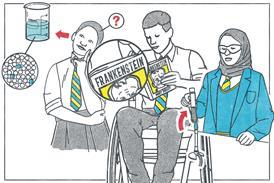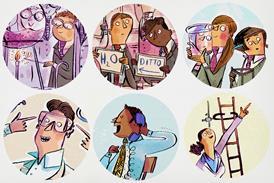Wipe clean and reuse – question sheets that aid knowledge retention
After considering effective revision techniques, such as teacher Kemi Anigiobi’s folding retrieval strategy, I started thinking about how students practise recall. Kemi’s method was effective, but learners only revisited content a handful of times before needing fresh question sheets. I wondered if there was a way to revisit the same key knowledge regularly without printing new sheets every time.
Students can practise, make mistakes, check their answers and try again
That’s when I created my retrieval sheets. These sheets focus on helping students remember core facts, such as the charges on subatomic particles or reactivity trends in group 1 metals. Because they’re reusable, students can practise, make mistakes, check their answers and try again. Even learners who normally hesitate to attempt answers feel comfortable, knowing that every attempt is a fresh start.

Creating the sheets is simple. I design A4 sheets with a column of questions with space beside each one for answers. The back contains the answers. Writing the questions takes some thought. They shouldn’t be too easy nor too focused on specific past exam questions at any age group. The goal is to help students actively recall key facts, not just memorise answers.
Learners slide the sheet into a plastic wallet (attached to their exercise books), grab a whiteboard pen and start answering. They flip the sheet to check their answers, remove it from the wallet and date any mistakes next to the question on the sheet to revisit later. Then they wipe the wallet clean for the next time they attempt the questions. There’s no grading, no scores and no pressure – just consistent, zero-stakes practice.
How to use retrieval sheets
I first introduced retrieval sheets to my year 11 students (aged 15–16) as we revisited content from the previous year. The retrieval sheet often forms the do-now task at the start of lessons. As learners become more confident, I give them the option to choose their sheet, but I still guide them towards trickier topics.
Sometimes I assign specific sheets linked to upcoming lessons. For example, before teaching electrolysis, I ask students to revisit structure and bonding. This method works well with my post-16 students too. They often gravitate towards tougher topics like group 2 chemistry.
When learners select sheets they’re struggling with, I can quickly assess who needs extra help without formal tests. I walk round and look at which sheets students are doing. I often make a note on my seating plan so I can target learners with relevant questions during the lesson and see if there’s a pattern with lots of students selecting the same topics. I can then plan relevant intervention or starter activities.
The novelty of using whiteboard pens keeps younger students engaged
I also use this method at 11–14, focusing on foundational knowledge such as definitions and diagrams. The novelty of using whiteboard pens keeps younger students engaged. And yes, I introduce the concept of retrieval squirrels. Inspired by Inside Out, I explain that cartoon squirrels in our brains are responsible for retrieving facts. Some squirrels are organised, others … not so much. But every time we do retrieval practice, we’re training those squirrels.
I remind high-achieving students that this technique won’t get them a top grade on its own. It builds foundational knowledge they can apply in more challenging questions.
Don’t assume learners will naturally know how to use the sheets. I explicitly teach the process and purpose using ideas of working memory and long-term memory. Once students understand why they’re doing it, their engagement increases.
Are retrieval sheets effective?
Retrieval sheets help students make stronger links between topics. They’re not just parking prior learning, they’re building connections between new and prior knowledge. For example, when 14–16 learners start organic chemistry, they can already discuss covalent bonding without needing a full recap. And at 11–14, retrieval sheets helps students develop good revision habits early – and they actually enjoy using the sheets.
To build on the sheets, I want students to create flashcards for the questions they keep getting wrong. These will focus on gaps in their memory rather than repeating what they already know. It’s a targeted, manageable revision tool.
Retrieval sheets may appear simple, but they’re incredibly effective. Easy to create and easy to use, they really help train those retrieval squirrels.
Lucy Wallis








No comments yet